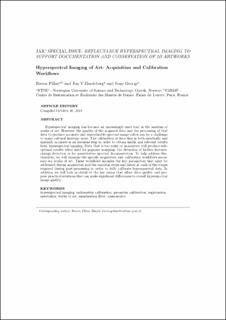| dc.contributor.author | Pillay, Ruven Lucio Saravana | |
| dc.contributor.author | Hardeberg, Jon Yngve | |
| dc.contributor.author | George, Sony | |
| dc.date.accessioned | 2020-03-25T12:17:21Z | |
| dc.date.available | 2020-03-25T12:17:21Z | |
| dc.date.created | 2019-06-13T19:15:17Z | |
| dc.date.issued | 2019 | |
| dc.identifier.citation | Journal of the American Institute for Conservation. 2019, 58 (1-2), 3-15. | en_US |
| dc.identifier.issn | 0197-1360 | |
| dc.identifier.uri | https://hdl.handle.net/11250/2648584 | |
| dc.description.abstract | Hyperspectral imaging has become an increasingly used tool in the analysis of works of art. However, the quality of the acquired data and the processing of that data to produce accurate and reproducible spectral image cubes can be a challenge to many cultural heritage users. The calibration of data that is both spectrally and spatially accurate is an essential step in order to obtain useful and relevant results from hyperspectral imaging. Data that is too noisy or inaccurate will produce sub-optimal results when used for pigment mapping, the detection of hidden features, change detection or for quantitative spectral documentation. To help address this, therefore, we will examine the specific acquisition and calibration workflows necessary for works of art. These workflows include the key parameters that must be addressed during acquisition and the essential steps and issues at each of the stages required during post-processing in order to fully calibrate hyperspectral data. In addition, we will look in detail at the key issues that affect data quality and propose practical solutions that can make significant differences to overall hyperspectral image quality. | en_US |
| dc.language.iso | eng | en_US |
| dc.publisher | Taylor & Francis | en_US |
| dc.title | Hyperspectral imaging of art: Acquisition and calibration workflows | en_US |
| dc.type | Peer reviewed | en_US |
| dc.type | Journal article | en_US |
| dc.description.version | acceptedVersion | en_US |
| dc.source.pagenumber | 3-15 | en_US |
| dc.source.volume | 58 | en_US |
| dc.source.journal | Journal of the American Institute for Conservation | en_US |
| dc.source.issue | 1-2 | en_US |
| dc.identifier.doi | 10.1080/01971360.2018.1549919 | |
| dc.identifier.cristin | 1704771 | |
| dc.description.localcode | Locked until 26.8.2020 due to copyright restrictions. This is an [Accepted Manuscript] of an article published by Taylor & Francis, available at https://doi.org/10.1080/01971360.2018.1549919 | en_US |
| cristin.ispublished | true | |
| cristin.fulltext | original | |
| cristin.fulltext | postprint | |
| cristin.qualitycode | 2 | |
